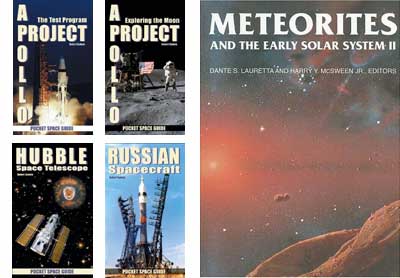Reviews: books big and smallby Jeff Foust
|
| As with the previously-reviewed pocket guides, these books are less for space “aficionados” than for beginners just starting out and desiring to wade into shallow waters rather than diving into the deep end. |
Project Apollo: The Test Program, Project Apollo: Exploring the Moon, Hubble Space Telescope, and Russian Spacecraft are the latest in the series of “Pocket Space Guides” by Apogee Books, earlier versions of which have been reviewed here (See “Review: pocket guides to space”, The Space Review, June 5, 2006.) These books follow the same pattern as their predecessors: each is 96 pages long, with about a 50-50 mix of text and full-color photos. The two Project Apollo books are really two halves of an extended history (if “extended” can be used in regard to 96-page books): the first covers everything from the early development of the Apollo spacecraft and Saturn rockets through Apollo 10, while the second covers Apollos 11 through 17. Hubble Space Telescope, as the name suggests, is an overview of that spacecraft, including its history, technical details, and scientific accomplishments. Russian Spacecraft provides a history of the development of Soviet/Russian launch vehicles and manned spacecraft primarily; there is very little about unmanned spacecraft, save for the historical early Sputnik and Luna missions.
As with the previously-reviewed pocket guides, these books are less for space “aficionados”—who already likely know everything, or almost everything, contained within their covers—than for beginners just starting out and desiring to wade into shallow waters rather than diving into the deep end. The two Project Apollo books may be of interest to more knowledgeable people, though, since they serve, to some degree, as pocket reference guides to the various Apollo missions: useful if you need to look up in a hurry, say, the time of the Apollo 9 launch or what ship handled the recovery of Apollo 15.
At the other extreme of the size spectrum is Meteorites and the Early Solar System II. This book is the latest in the University of Arizona Space Science Series, which for over three decades has been churning out massive tomes that serve as canonical references in the field. Seeing this book brought me back to my undergraduate and graduate studies in planetary science: these books were bibles for students trying to get up to speed on a particular area of research, and were so widely used that one could make a very educated guess on a scientist’s areas of research based on just what volumes in this series were in his or her office.
| The compilation of these papers is, in effect, a snapshot of our knowledge of the subject as of 2006. |
As the title suggests, Meteorites and the Early Solar System II reveals the state of our knowledge of meteorites and what they teach us about the early history of the solar system. The book consists of about 40 separate papers, from 88 authors, on topics like “The Physics and Chemistry of Nebular Evolution”, “Solar System Deuterium/Hydrogen Ratio”, and “Shock Effects in Meteorites”. The compilation of these papers is, in effect, a snapshot of our knowledge of the subject as of 2006: any sufficiently-interested person with some background in physics, chemistry, and planetary science could read this and get up to speed on this field of study quickly.
Of course, it’s unlikely that anyone (other than the editors and perhaps some of the authors and other scientists) will ever read this book cover-to-cover: it’s meant as a reference book for students and scientists who need to learn about a specific topic contained within it. For that purpose Meteorites and the Early Solar System II will likely be as successful as its predecessors, lining the bookshelves of libraries and scientists’ offices. It’s unlikely to find a home next to any of the pocket space guides, which serve a very different audience, but that’s probably a good thing for the pocket guides: the size difference is so great they would be crushed if Meteorites fell on them!
